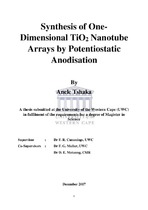| dc.description.abstract | TiO2 nanomaterials, in particular nanotubes, are some of the most studied materials, as they are
considerably important in technological and biological applications due to their unique
electronic properties and biocompatibility. For example, vertically aligned TiO2 nanotubes
play a crucial role in photovoltaics as they enhance the charge separation as a result of their
excellent photo-catalytic properties in the presence of organic dye molecules, and provide a
superior one-dimensional transport route compared to nanoparticle films. There are numerous
techniques used to synthesise TiO2 nanotubes, such as chemical vapor deposition (CVD),
template based techniques, anodisation, to name but a few. However, due to its non-toxicity
environmental friendliness and cost-effectiveness, anodisation is the most common technique
to synthesise TiO2 nanotubes. In addition anodisation allows for control over the morphology
when tailoring the anodisation parameters such as voltage, concentration, temperature and
duration. It is well-documented that the as-synthesised TiO2 nanotubes via anodisation
technique are amorphous and require post-treatment at elevated temperature (above 280 degrees C) to
induce crystallinity into anatase phase. Further increase in annealing temperature results in
crystallisation in either rutile or mixed phase structure. | |

